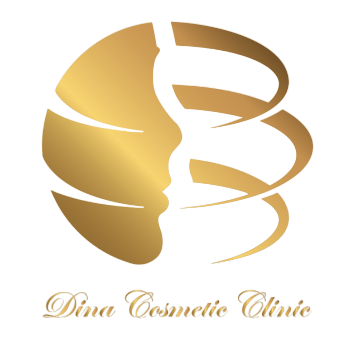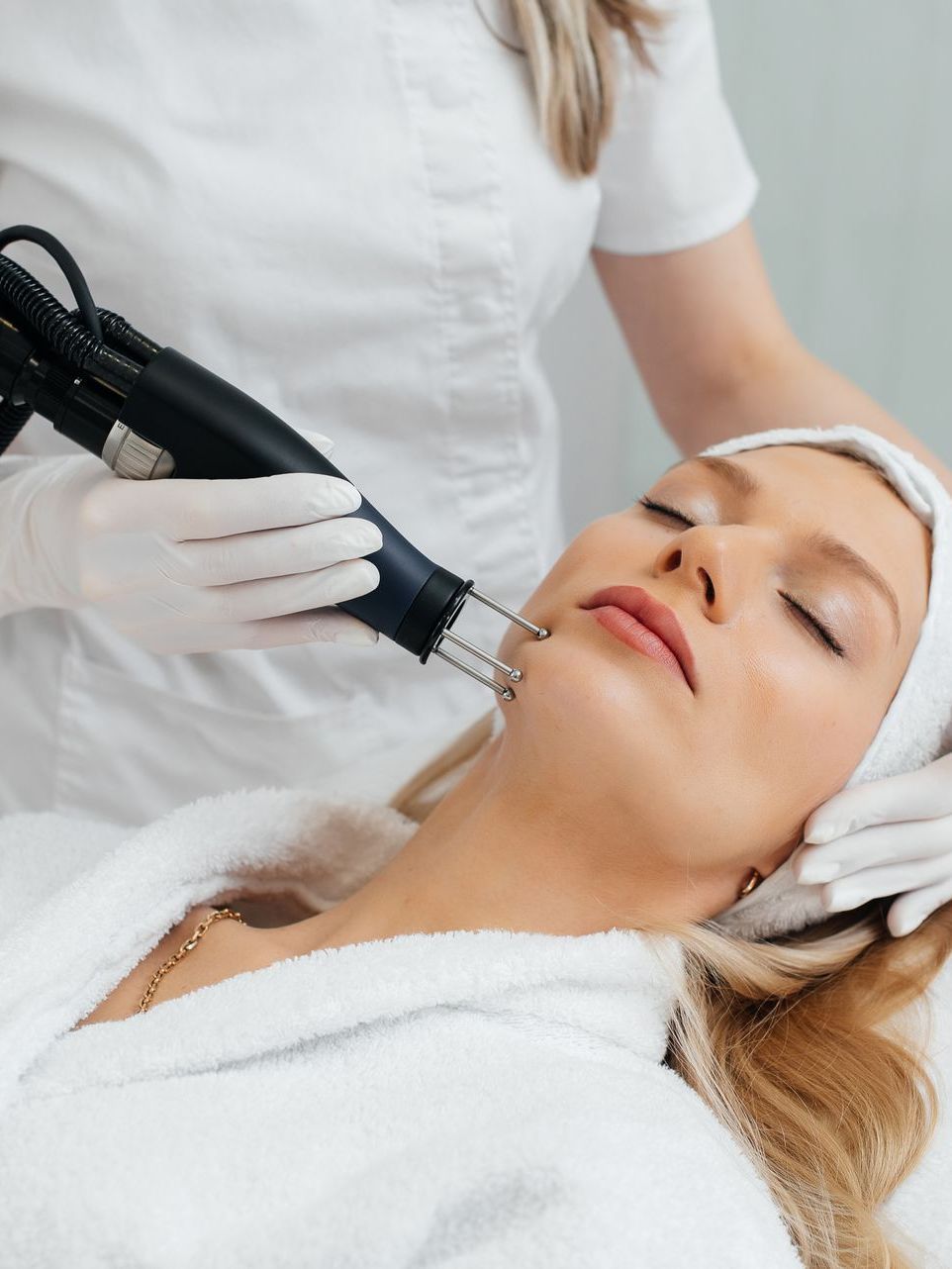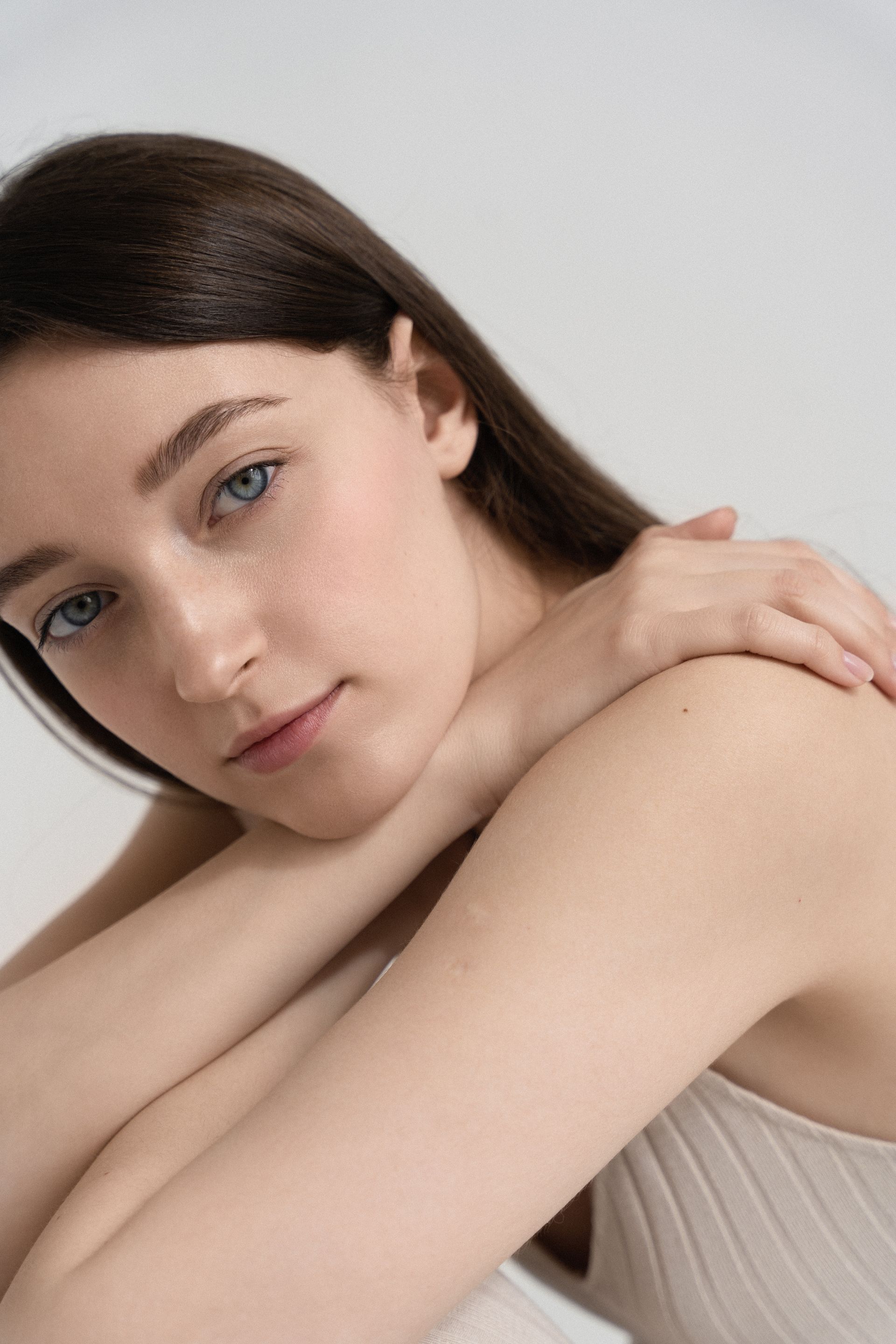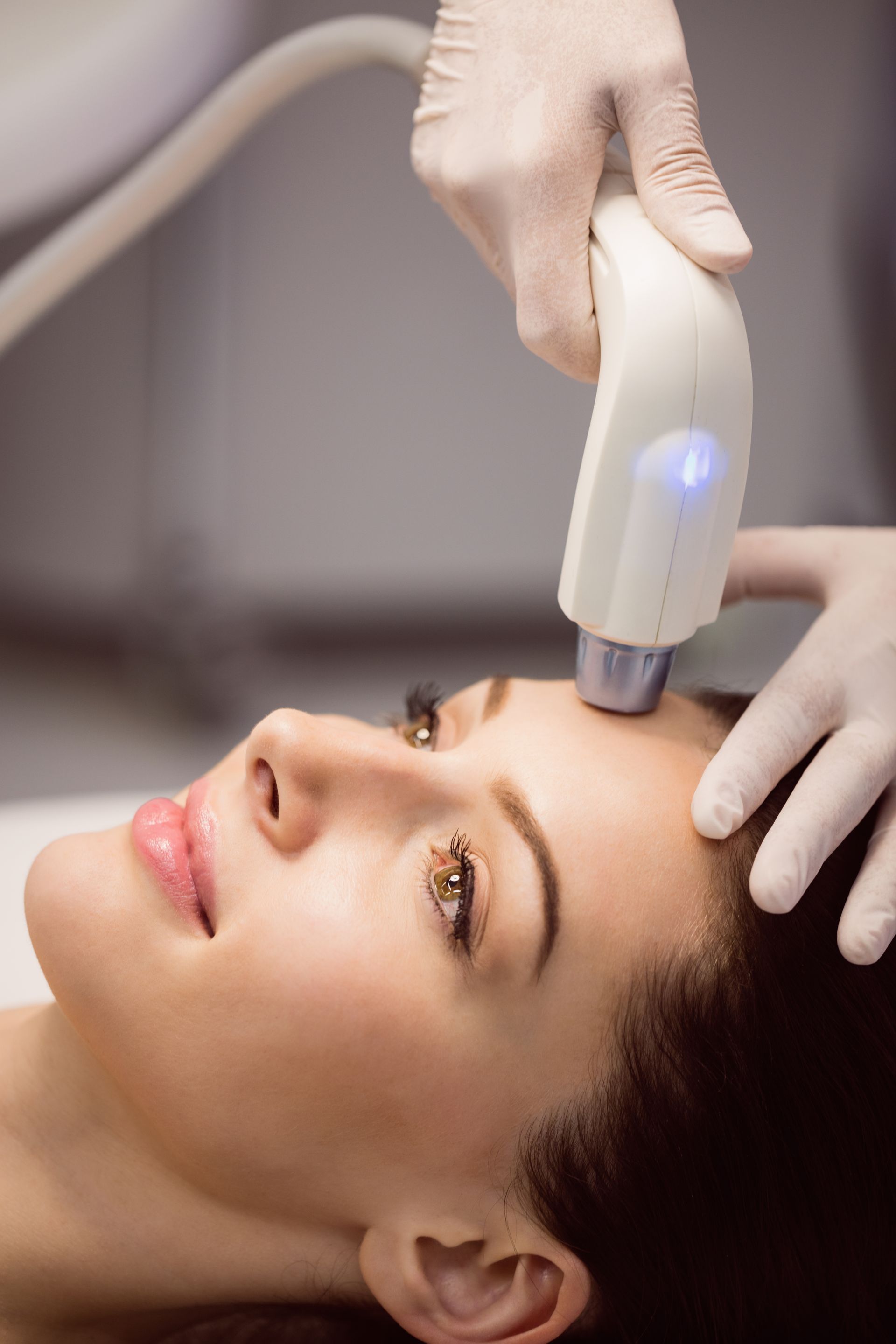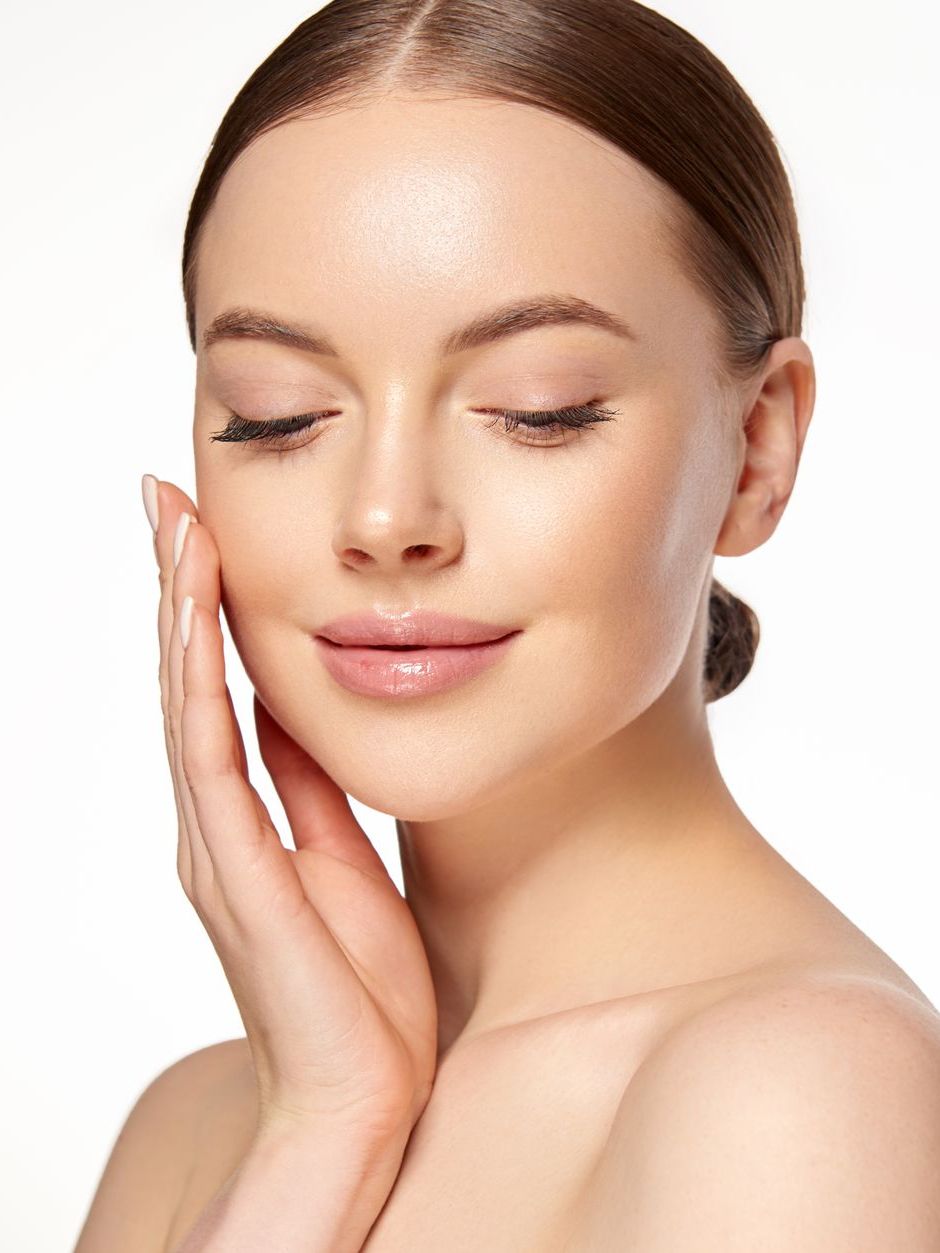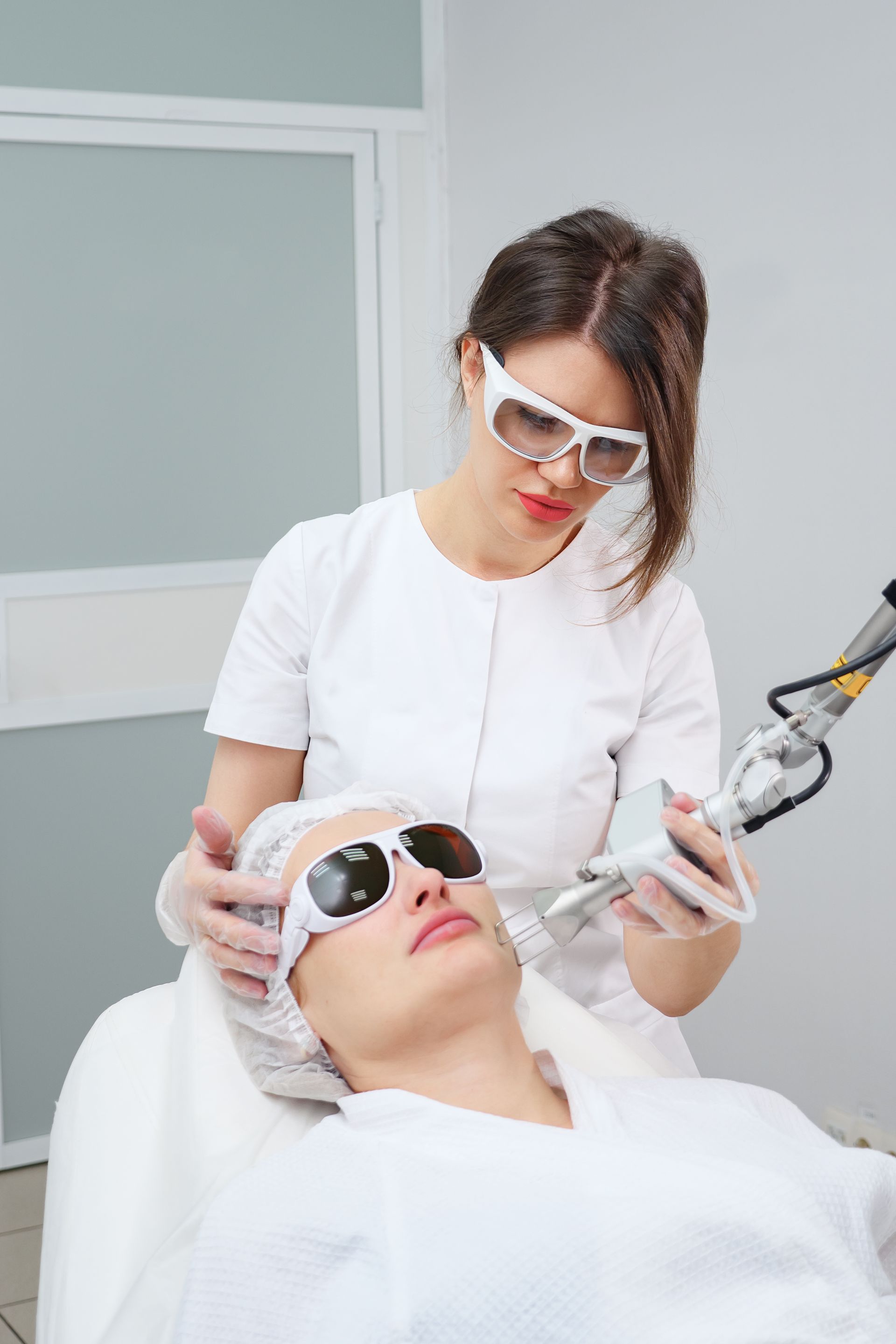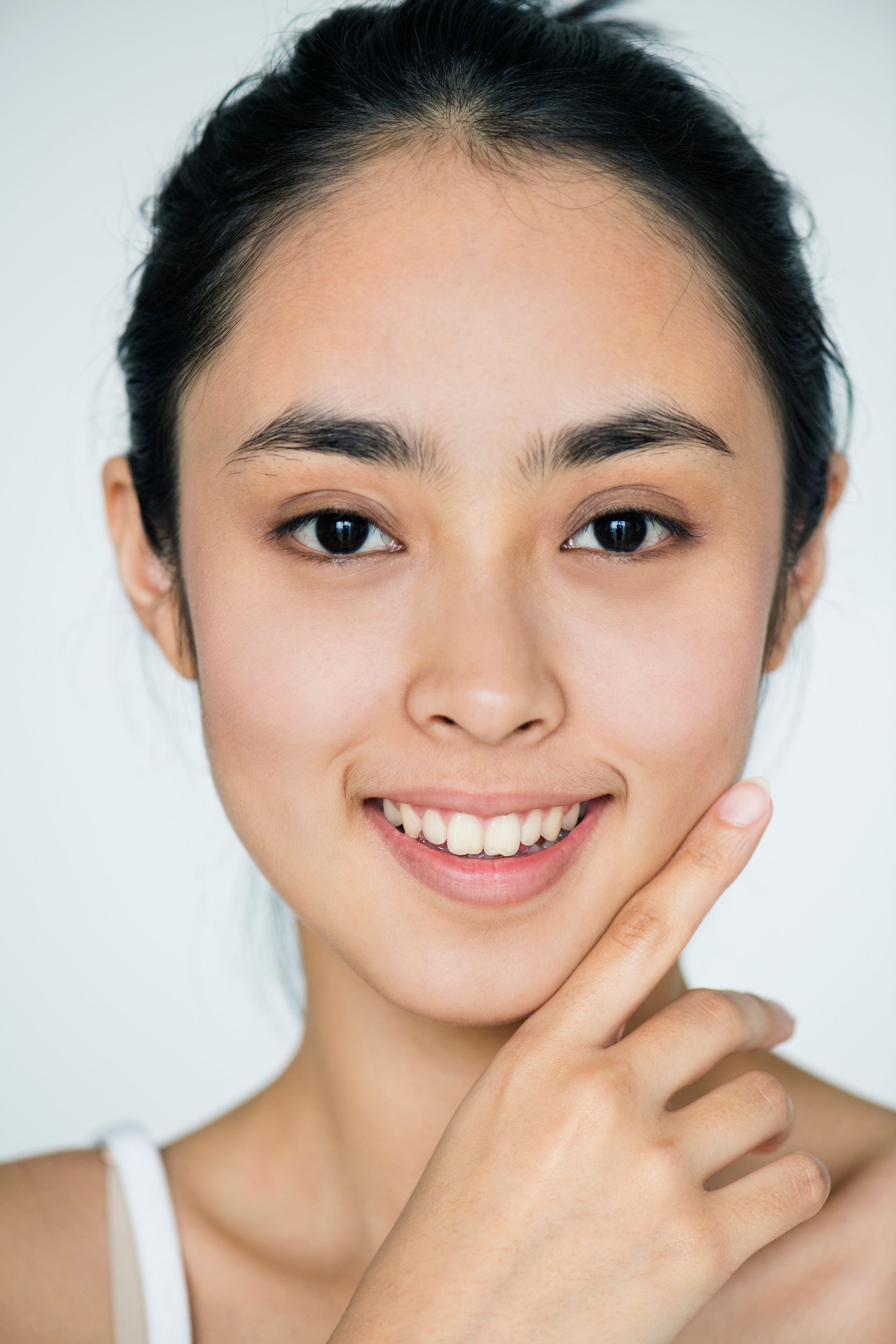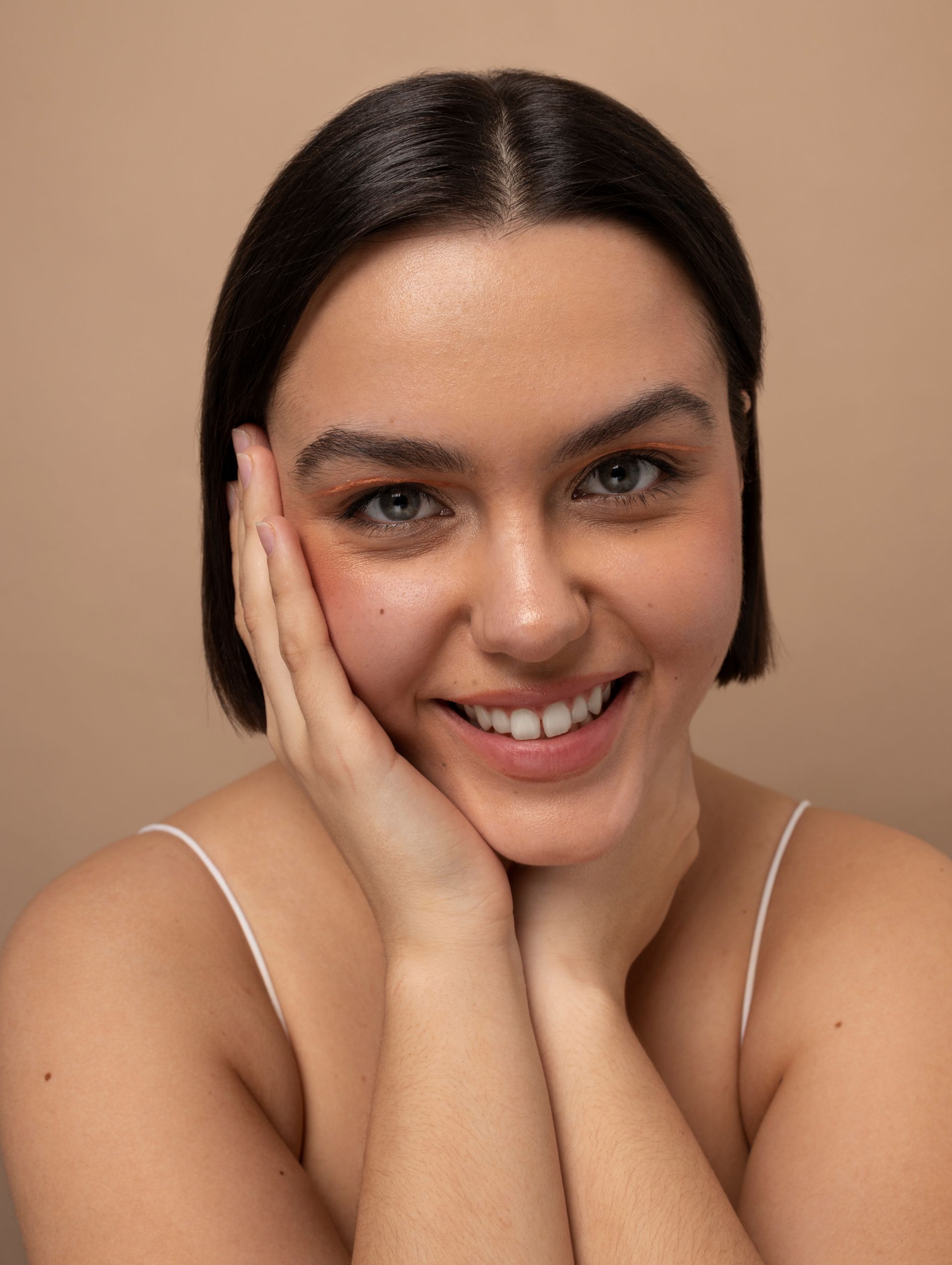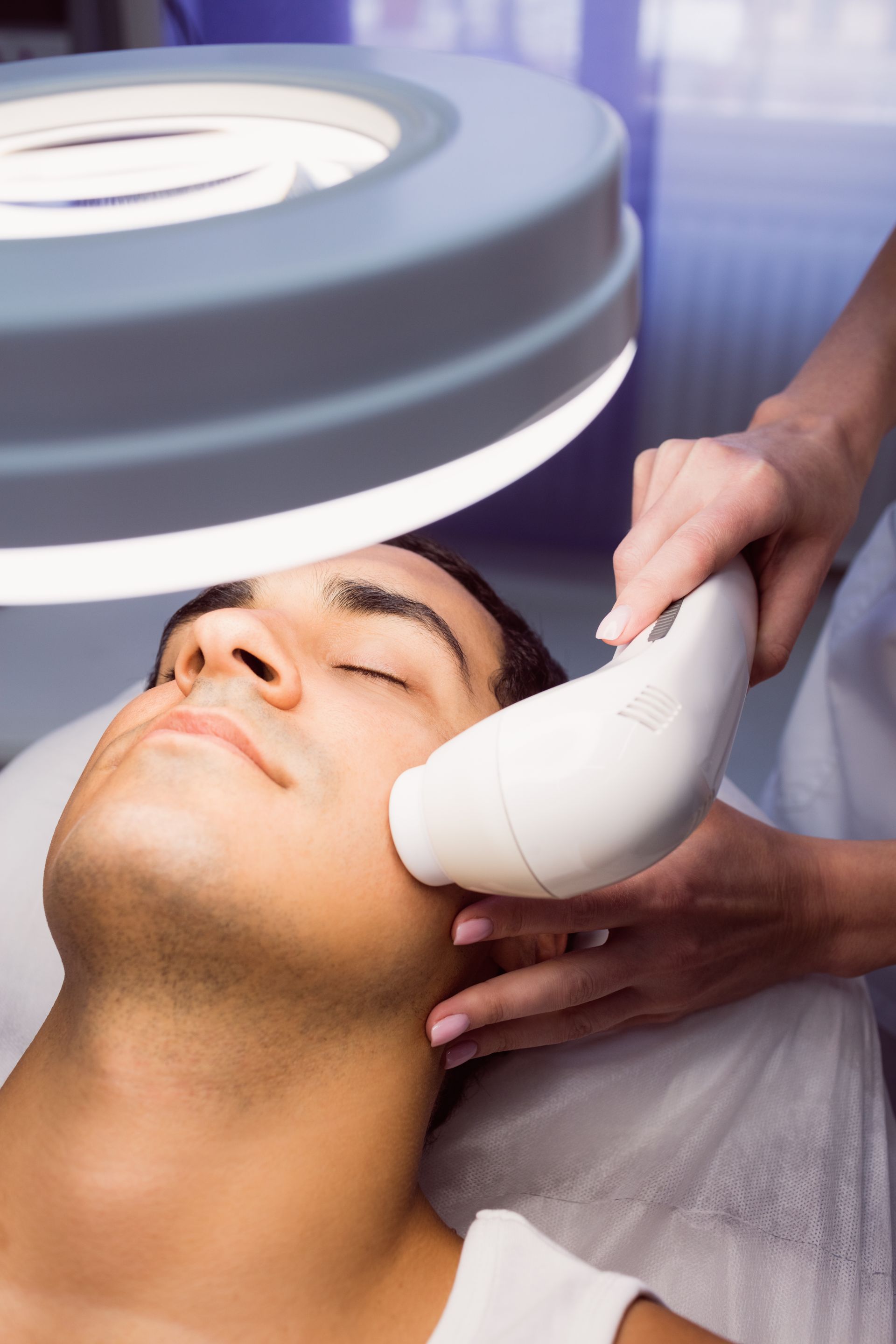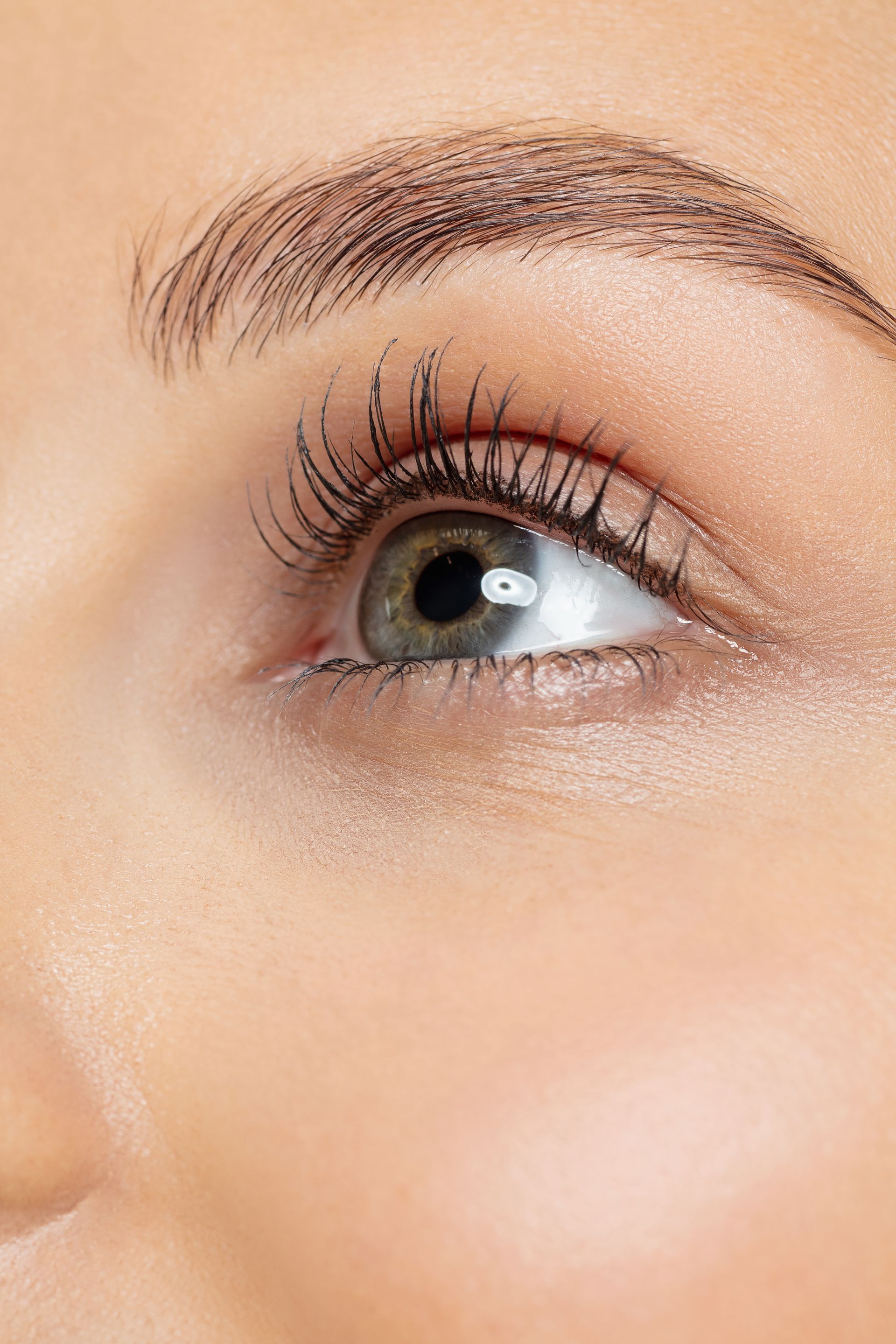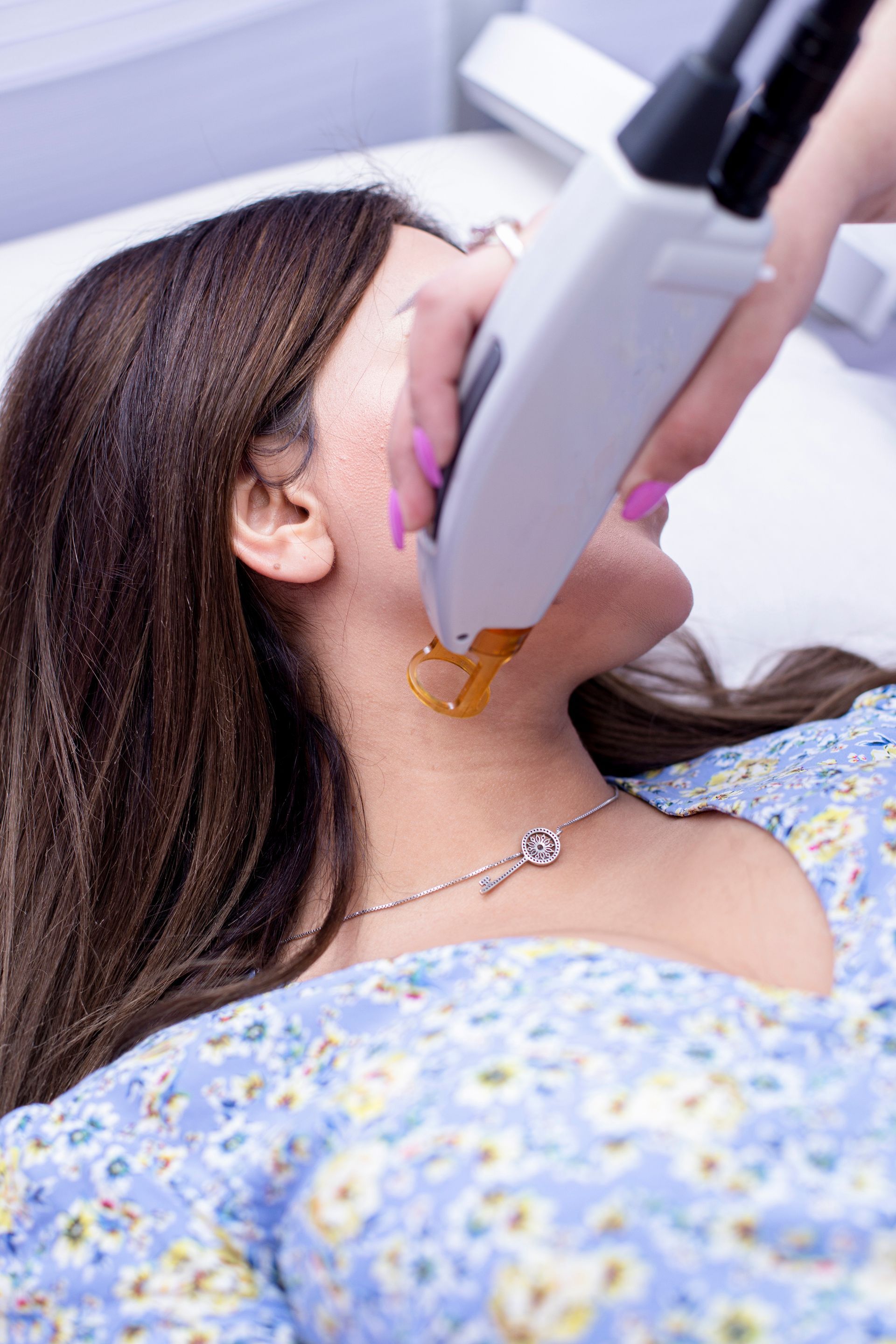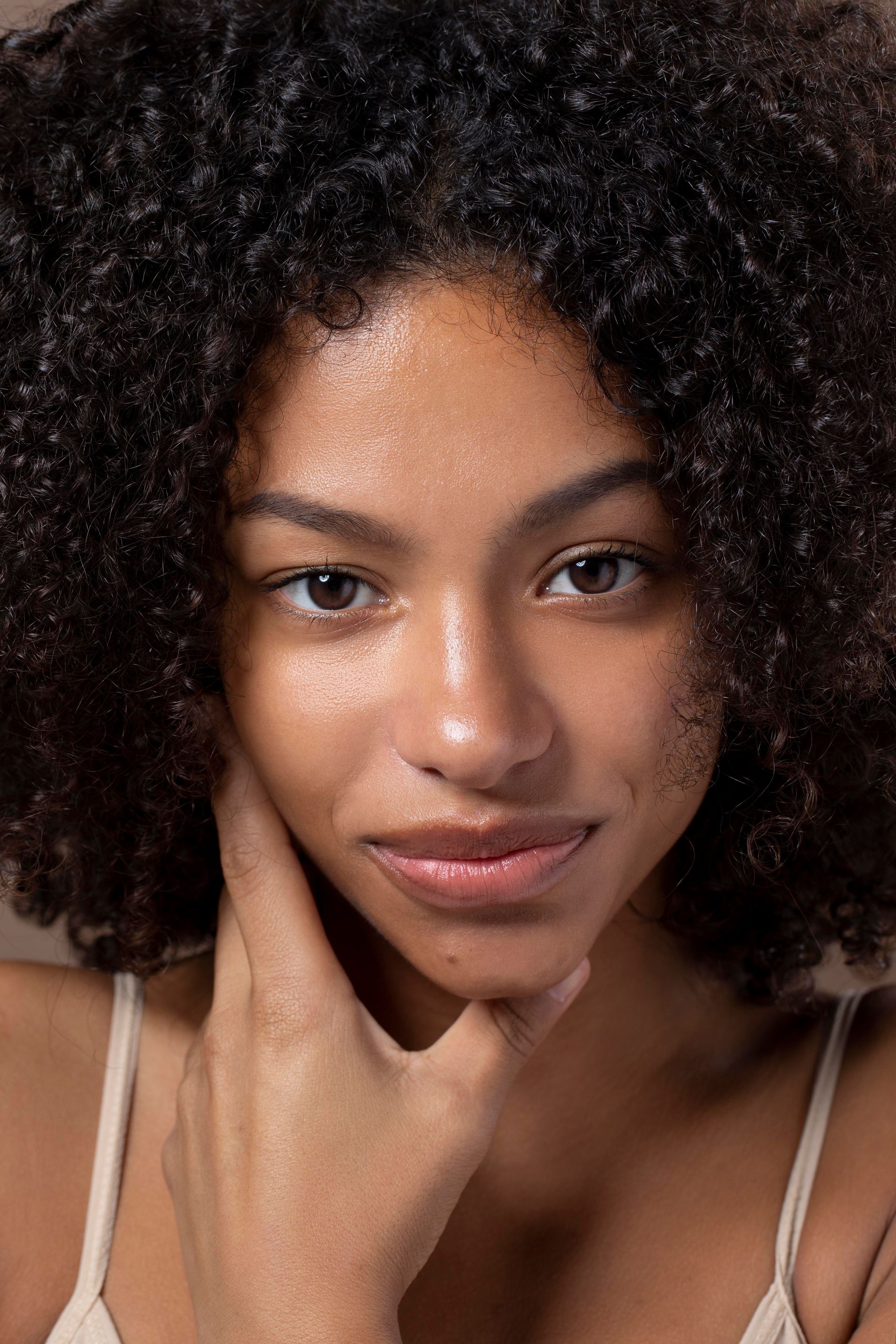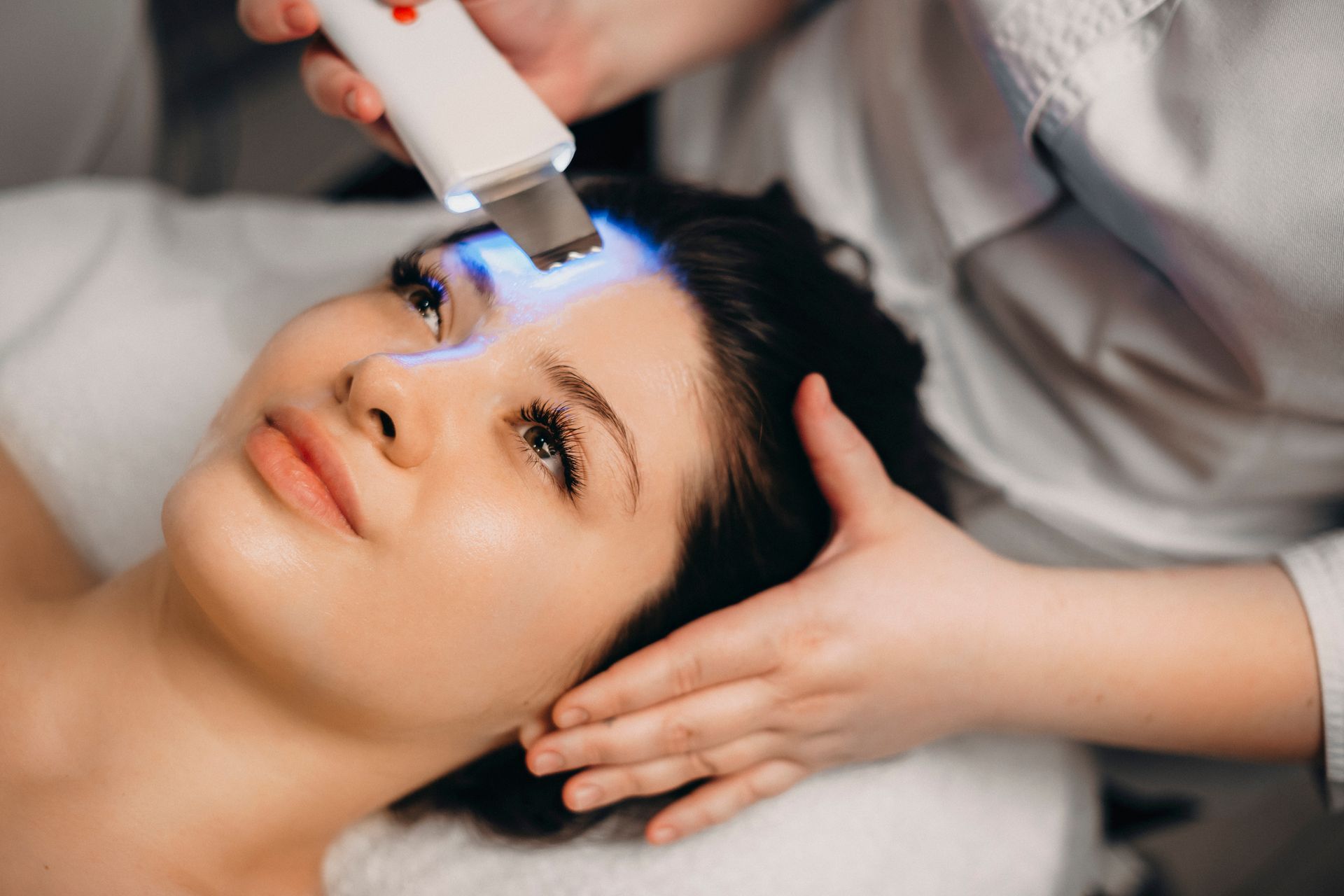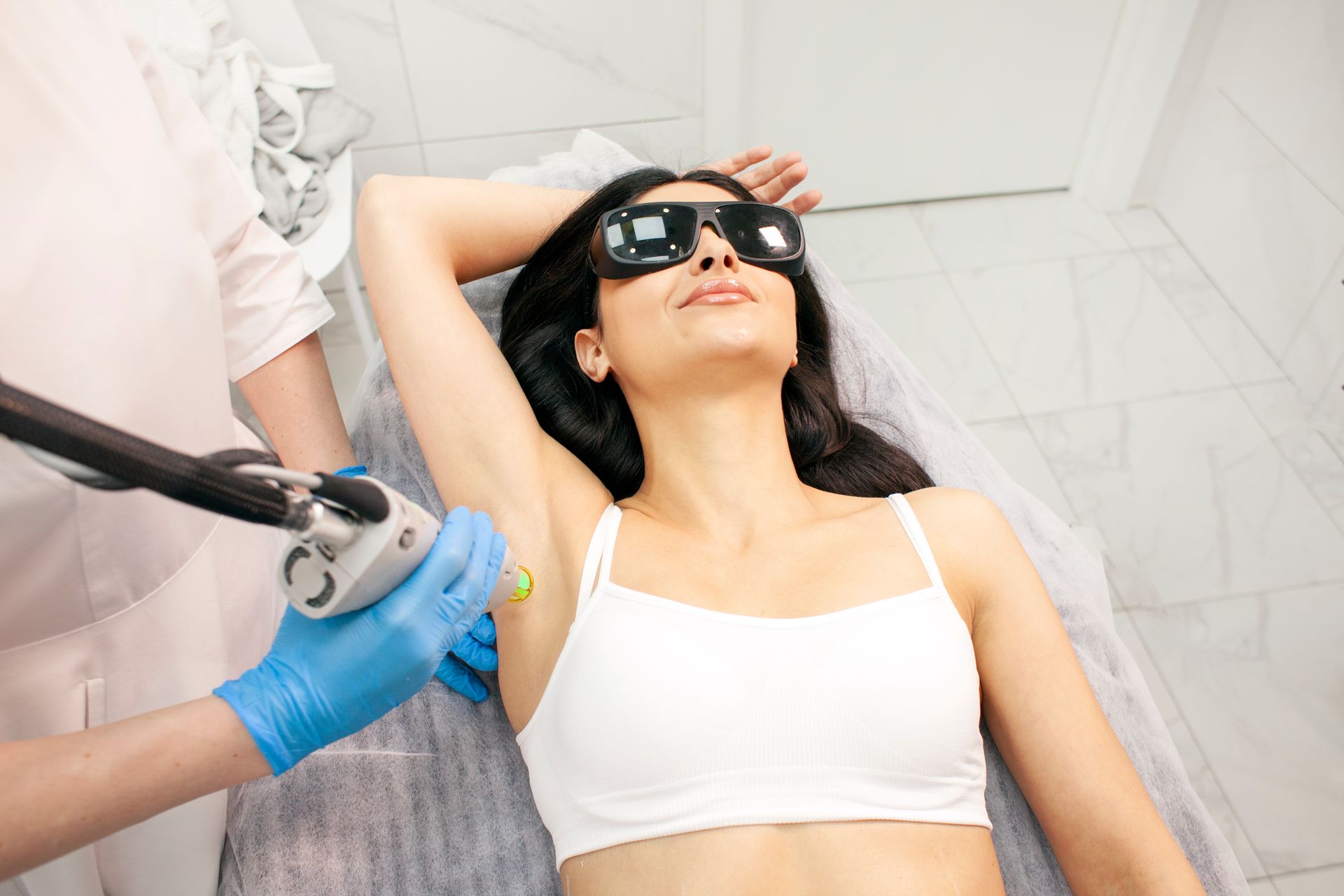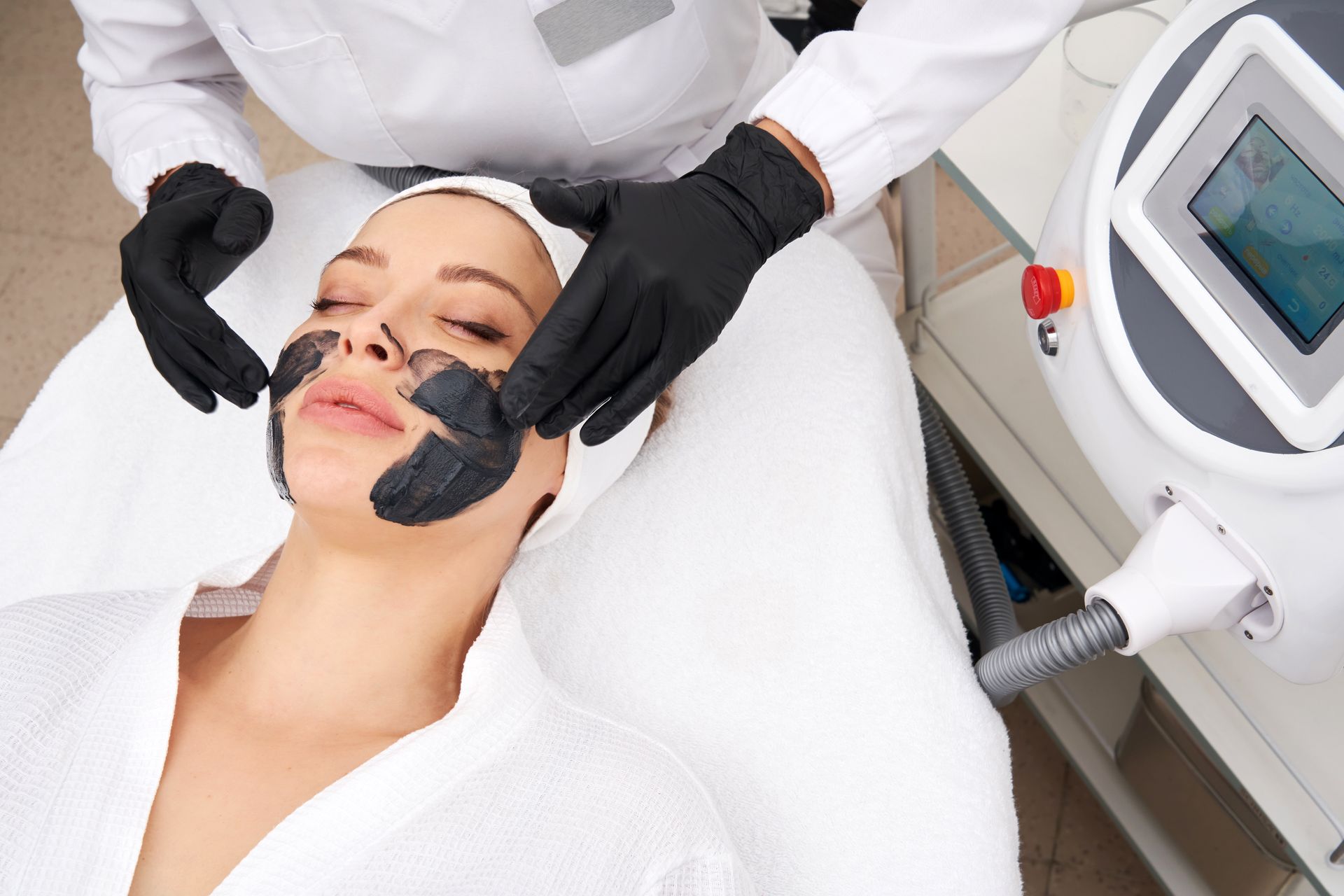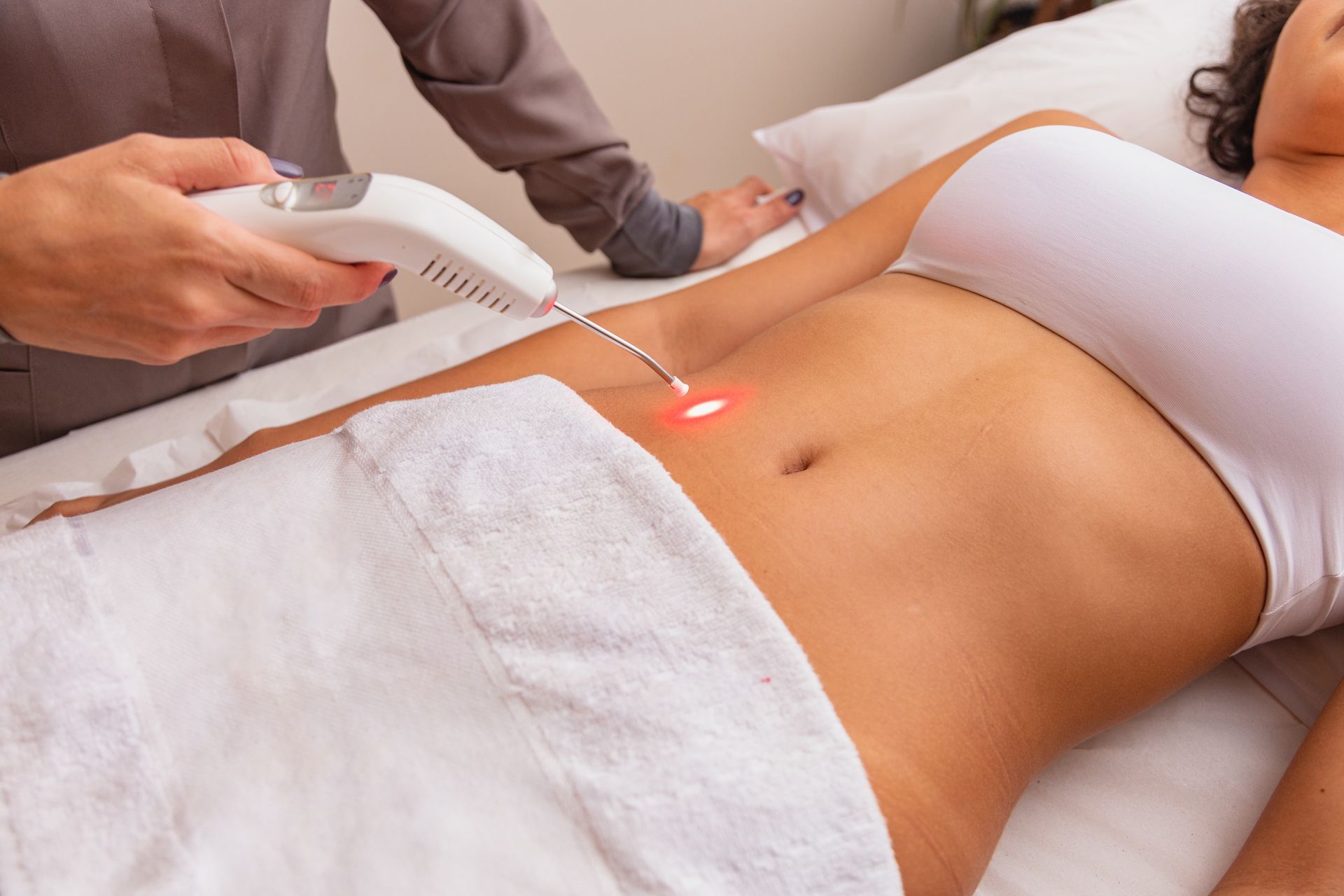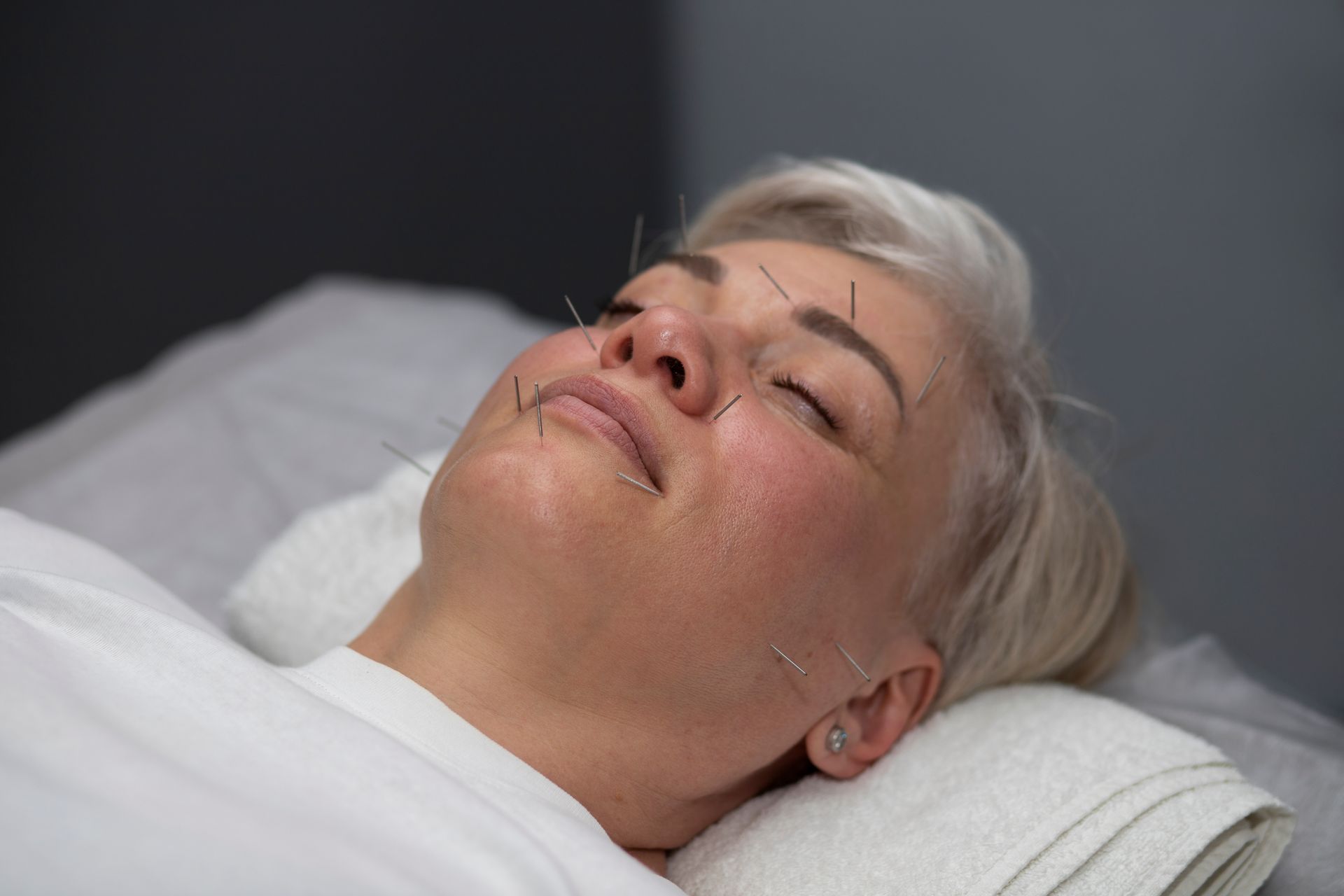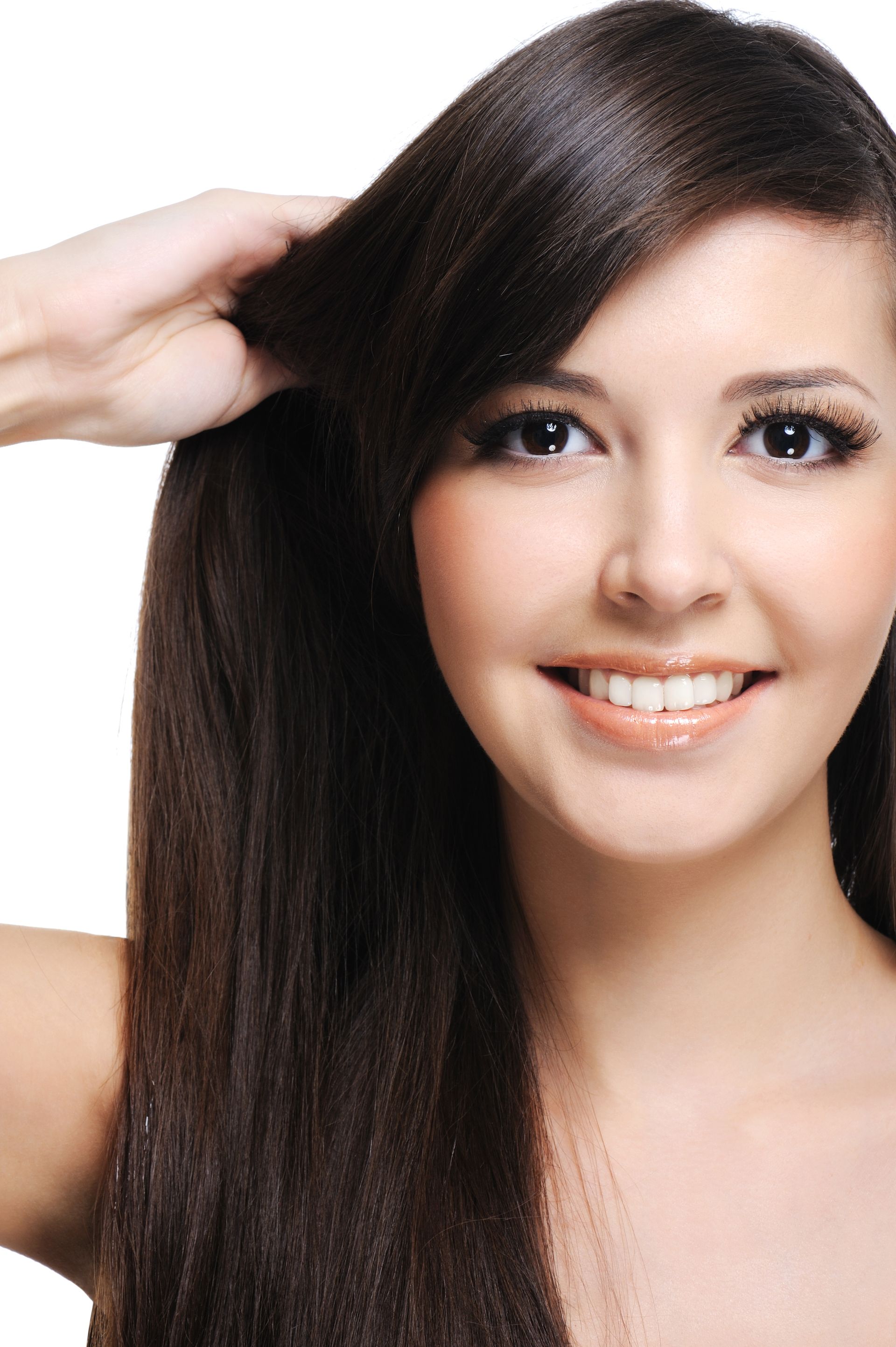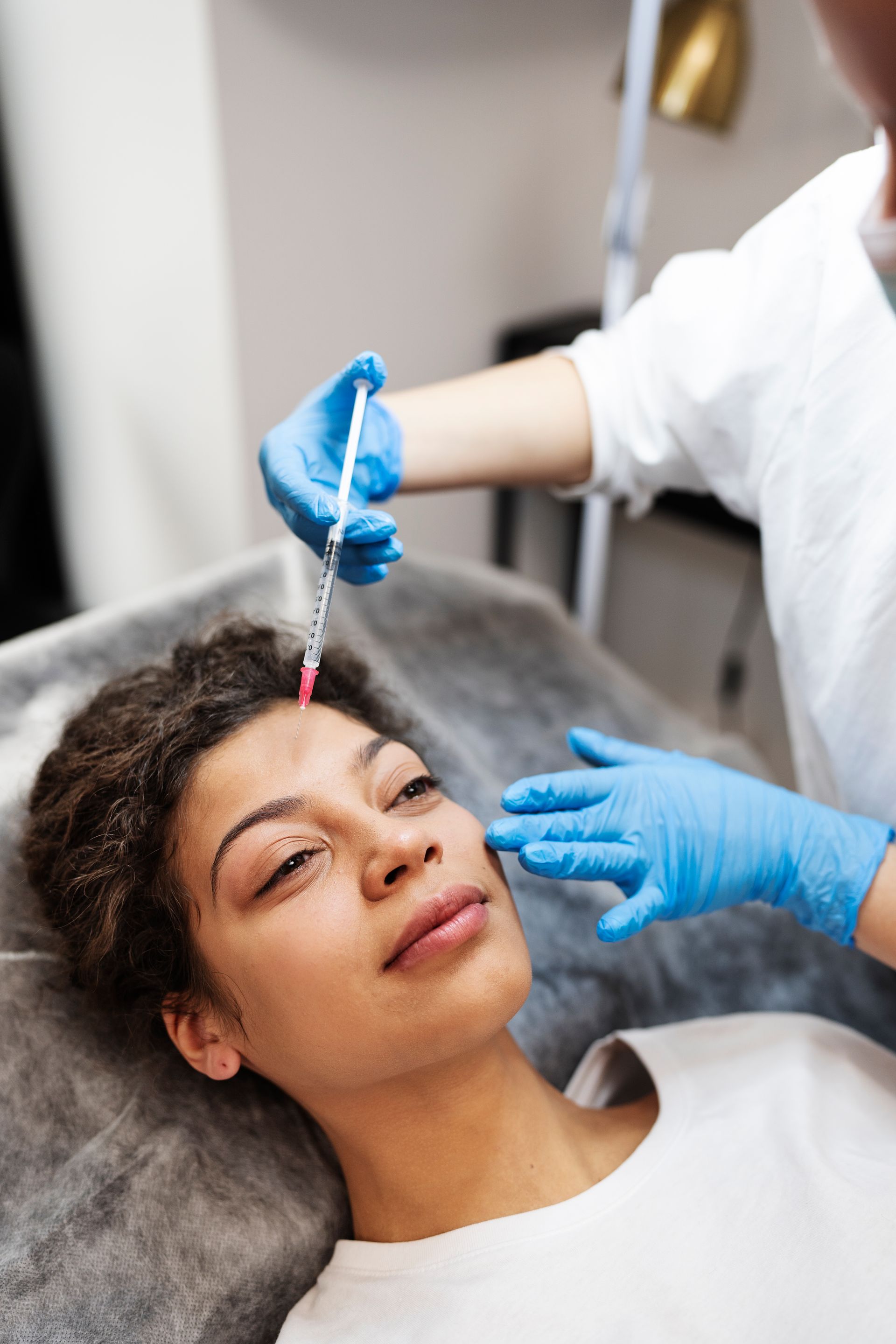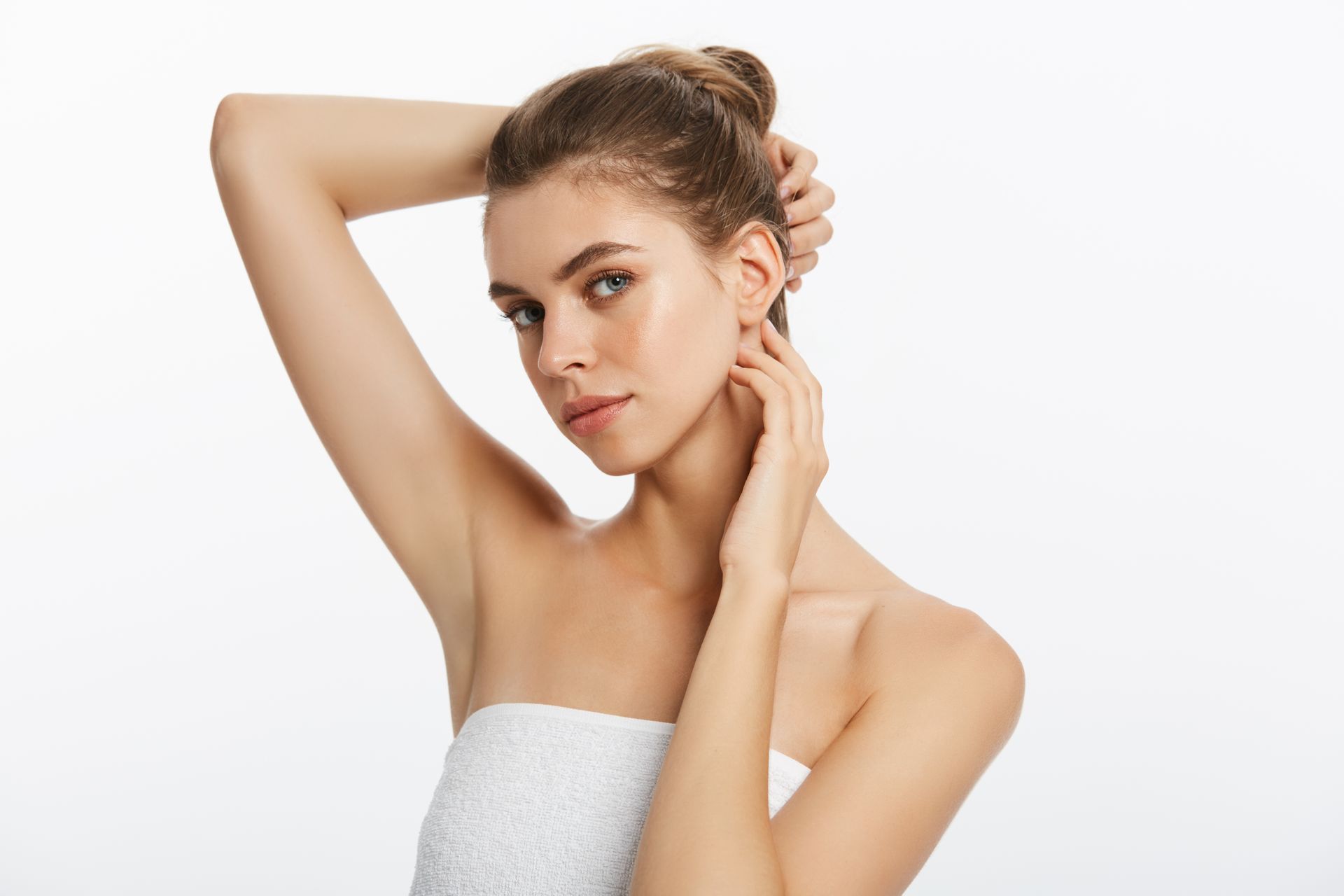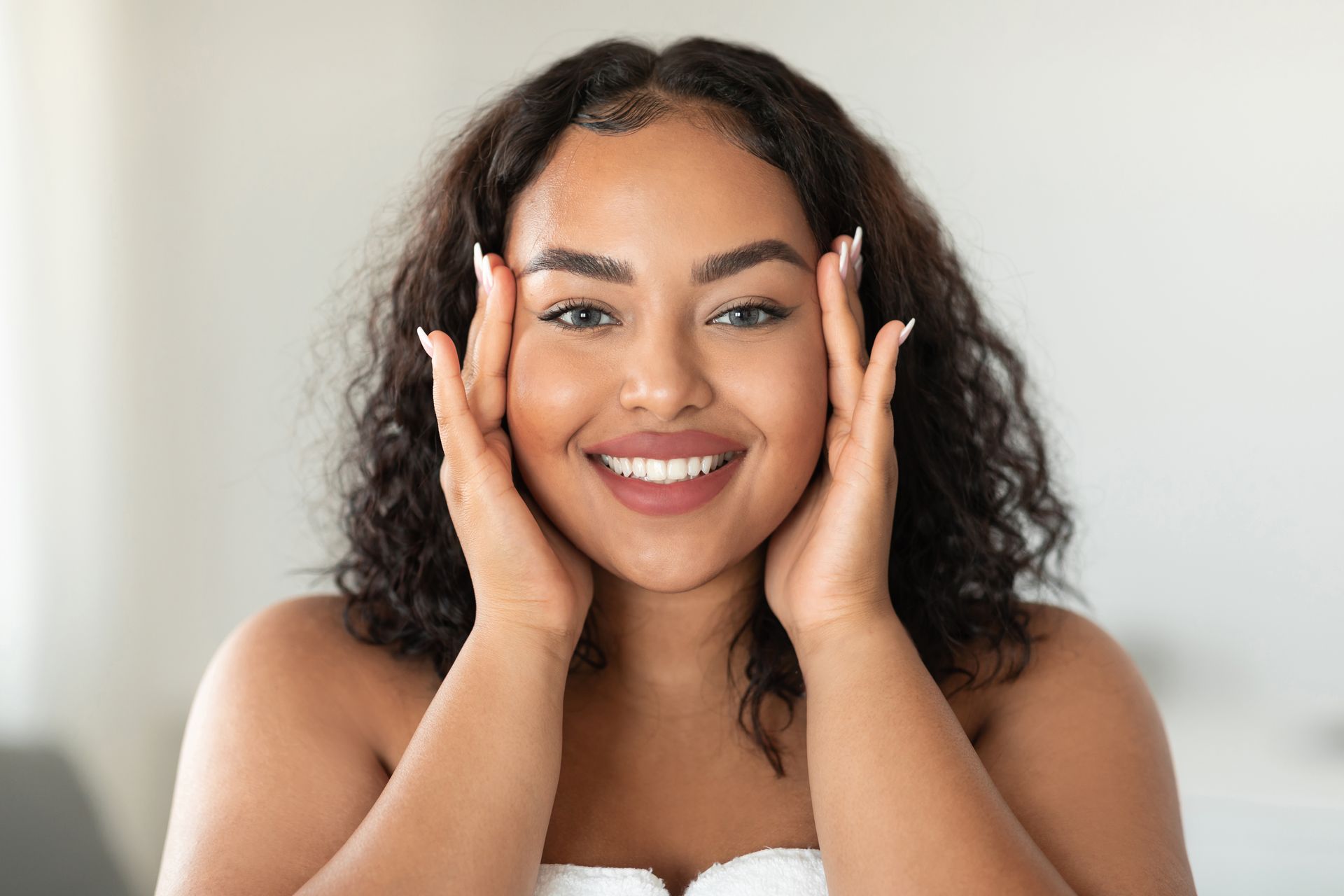Get In Touch
Call: (437) 533-4170
Email: info@dinacosmetic.com
Business Hours
- Mon - Fri
- -
- Saturday
- -
- Sunday
- Closed
Spring Promotions: Mini Lip Filler now $200 with a free small area Laser Hair Removal; 1 syringe Filler now $350 with a free medium area Laser Hair Removal; Botox 40 units now $280 with a free sunscreen cream; RF Double Chin Removal now $75 with a free Eyelift
Laser Treatments
Unleashing Radiance with Advanced Laser Treatments
Welcome to a new era of skin revitalization with Dina Cosmetic Clinic's Laser Treatments. Our state-of-the-art laser technology offers a suite of services designed to tackle various skin concerns, including hyperpigmentation, sun and age spots, acne, and more. We aim to provide you with the most effective treatments for healthier, radiant, and youthful-looking skin.
In a comfortable and safe environment, our experienced professionals will guide you through each step, ensuring you receive the highest standard of care. Embrace the transformative power of our laser treatments and embark on your journey towards enhanced beauty and confidence.
Laser Therapy for Targeted Skin Transformations
Our advanced laser technology addresses a wide array of skin concerns, from age spots to uneven skin tone and texture, offering you an opportunity to reveal your most radiant skin yet. Let's delve into the journey of laser therapy, its scientific principles, our superior technology, and the role of different wavelengths in this transformative treatment.
-
The Evolution of Laser Therapy
Laser Therapy has experienced significant advancements since its inception by Theodore H. Maiman in 1960. The initial concept, which utilized ruby as a lasing medium, has been continuously refined to offer superior cosmetic treatments today.
-
The Science Behind Our Laser Treatments
The scientific principle propelling this innovative technology is simple yet revolutionary. By using amplified light, specific chromophores are targeted and destroyed, providing a safe and effective method for various skin treatments.
-
The Light 4V EVO Series: What is it?
As a testament to the relentless pursuit of excellence in laser therapy, the Light 4V EVO series stands out. This cutting-edge device, approved by both FDA and Health Canada, combines three true-laser wavelengths, IPL, and an ablative fractional device for comprehensive skin treatments.
-
The Light 4V EVO Series: How it Works?
Each wavelength in the Light 4V EVO series is meticulously designed to target different chromophores such as Hemoglobin, melanin, and water or collagen. This specificity allows for effective treatment of a variety of skin concerns including vascular lesions, pigmented lesions, and more.
Skin Rejuvenation: Unveil Your Youthful Glow
Discover a revitalized complexion with our Skin Rejuvenation treatments at Dina Cosmetic Clinic. Offering a combination of advanced technology and expert technique, we aim to restore your skin's youthful glow and smooth texture.
-
Understanding Skin Rejuvenation Treatment
Our skin rejuvenation treatment is an advanced procedure that employs laser technology to stimulate collagen and water in the skin. These are the essential chromophores targeted to facilitate the rejuvenation process. This technique is designed to restore the youthful appearance of your skin, making it smoother, firmer, and more radiant.
-
Benefits of Our Laser Therapy for Skin Rejuvenation
The skin rejuvenation procedures at Dina Cosmetic Clinic are highly beneficial due to their ability to provide near-instant results. The treatment process is entirely painless, allowing for a comfortable and stress-free experience. Another remarkable advantage is that there is no downtime required after treatment, meaning you can resume your daily activities immediately.
-
Our Process for Skin Rejuvenation
At Dina Cosmetic Clinic, we pride ourselves on employing a detailed and personalized approach to skin rejuvenation. We begin with a thorough assessment of your skin type and condition, which allows us to tailor the treatment to your specific needs. The laser therapy session involves directing concentrated light pulses to the target areas, stimulating collagen production and promoting skin renewal.
-
Treatment Intervals and Aftercare Advice
Typically, our skin rejuvenation treatments are conducted as a series of sessions at 3-week intervals. This scheduling allows for optimal results as the skin begins to take on a more youthful and clear appearance after the first few sessions. For aftercare, we recommend maintaining a regular skincare routine and avoiding excessive sun exposure to sustain the effects of the treatment. Further personalized advice will be provided by our professionals based on your specific skin condition.
Erase Vascular Lesions with Our Advanced Treatments
At Dina Cosmetic Clinic, we believe in harnessing the power of advanced technology to enhance your natural beauty. Our Vascular Laser treatments are a perfect example of this. Specially designed to address and eliminate vascular lesions, these treatments use targeted laser therapy to improve the appearance of your skin, restoring its natural, unblemished state.
-
Understanding Vascular Lesions
Vascular lesions are benign skin imperfections where blood vessels become visible through the skin, causing noticeable blemishes. They can appear on almost any part of the body but are most commonly found on the face or legs. Despite being harmless, they often cause discomfort due to their appearance, prompting many to seek treatment.
-
Causes Behind Vascular Lesions
Several factors can contribute to the development of vascular lesions. These include aging, genetic predisposition, hormonal fluctuations, and prolonged exposure to the sun. Understanding the underlying cause is crucial as it helps us tailor an effective, personalized treatment plan for each client.
-
Our Approach to Vascular Lesion Treatment
At Dina Cosmetic Clinic, we use state-of-the-art vascular laser technology to treat vascular lesions. The laser specifically targets the red pigment (hemoglobin) in the blood vessels. This targeted approach ensures the pigment is heated and destroyed without affecting the surrounding skin or tissues, offering a safe and effective treatment solution.
-
Duration and Potential Side Effects of the Treatment
Each laser treatment session typically lasts a few minutes and may require 1-2 sessions depending on the size and severity of the vascular lesion. The procedure has minimal side effects, which may include temporary redness or swelling at the treatment site. However, these are typically mild and subside within a few hours to days following the treatment. Our experts at Dina Cosmetic Clinic will provide detailed post-treatment care instructions to ensure a smooth recovery.
Hyperpigmentation Treatments: Unveiling Clear, Even-Toned Skin
Hyperpigmentation, a common skin concern characterized by darkened patches of skin, can significantly impact your self-confidence. At Dina Cosmetic Clinic, we offer advanced laser treatments to address various types of hyperpigmentation, helping you achieve an even, radiant complexion.
-
Various Types of Hyperpigmentation
Hyperpigmentation takes on many forms, including age spots, freckles, and melasma, among others. Each type has distinct characteristics and requires a specialized approach for effective treatment. At Dina Cosmetic Clinic, we have the expertise and technology to treat a wide range of hyperpigmentation conditions.
-
The Causes of Hyperpigmentation
Hyperpigmentation is typically caused by an excess production of melanin, the pigment responsible for skin and hair color. This can be triggered by various factors, including sun exposure, hormonal changes, age, and skin injuries. Understanding the root cause allows us to create personalized treatment plans for optimal results.
-
Our Approach to Treating Hyperpigmentation
We use advanced laser technology to treat hyperpigmentation effectively. The laser targets melanin in the skin's surface, heating and destroying it to remove the discoloration. This targeted approach ensures minimal impact on the surrounding skin, offering a safe and effective treatment solution.
-
What to Expect from Hyperpigmentation Treatment
Our laser treatments for hyperpigmentation are designed to reduce and eliminate dark patches, resulting in an even skin tone. While results vary depending on the severity of the condition, most clients see significant improvement after a series of treatments.
Freckle Reduction: Effective & Tailored Treatments
Freckles, small tan or light brown spots on your skin, are a common skin condition. While they're often associated with a unique charm, some people may feel self-conscious about their freckles. At Dina Cosmetic Clinic, we offer comprehensive treatments for freckles (Ephelides), assisting you in achieving a clear, flawless complexion that boosts your confidence.
-
Understanding Freckles and Their Types
Freckles are tiny, pigmented spots that frequently appear on sun-exposed skin areas. They come in different forms, such as Ephelides, which are typically light brown and tend to fade in the winter, and Solar Lentigines or 'sun spots', which are often darker and remain constant throughout the year. Understanding the specific type of freckles is a crucial first step in determining the most effective treatment approach.
-
Causes and Prevention of Freckles
The primary cause of freckles is sun exposure, which triggers an overproduction of melanin, the pigment that gives skin its color. Genetics also play a role, as certain people are more prone to developing freckles due to their genetic makeup. To prevent freckles, it's crucial to protect your skin from the sun by wearing sunscreen with a high SPF, avoiding peak sunlight hours, and wearing protective clothing.
-
Benefits of Laser Therapy for Freckles
Laser therapy is an effective treatment for reducing the appearance of freckles. The treatment uses concentrated light to target and break down the excess melanin causing the freckles, leading to a significant reduction in their visibility. Laser therapy for freckles not only improves the skin's appearance but also enhances its overall health and texture.
-
Our Process for Treating Freckles with Laser Therapy
At Dina Cosmetic Clinic, our laser therapy procedure for freckles involves directing concentrated light pulses onto the freckled areas. This light is absorbed by the melanin in the freckles, causing them to break down and gradually fade away. The number of treatments needed will depend on the quantity and size of the freckles. Aftercare involves protecting the skin from sun exposure and maintaining a good skincare routine to prevent the development of new freckles.
Melasma Treatments: Achieve Clear, Even-Toned Skin
Melasma, also known as Chloasma or the "mask of pregnancy," is a common skin condition characterized by brown or grayish patches on the face. At Dina Cosmetic Clinic, we understand the impact of Melasma on your self-esteem and offer advanced treatments to reduce its appearance and restore your skin's natural beauty.
-
Understanding Melasma
Melasma is a type of hyperpigmentation that primarily affects women. It manifests as symmetric, blotchy, brownish facial pigmentation and often occurs during pregnancy or with the use of oral contraceptives. Although harmless, it can cause significant cosmetic concern and emotional distress.
-
Benefits of Laser Treatment for Melasma
Laser treatment offers an effective solution for managing Melasma. By targeting the pigment cells in the skin, laser therapy can reduce the appearance of dark patches and even out skin tone. This treatment not only improves the visible signs of Melasma but also enhances overall skin health and texture, leaving patients with a smoother, more even complexion.
-
Types of Melasma and Their Response to Treatment
Melasma is classified into three types: epidermal (affecting the outer layer of skin), dermal (affecting deeper layers), and mixed. The response to treatment varies based on the type of Melasma. Epidermal Melasma often responds well to laser treatment, while dermal Melasma is more resistant. Mixed Melasma, the most common type, shows some response to laser treatment.
-
Our Treatment Process Melasma
At Dina Cosmetic Clinic, we use advanced laser technology to treat Melasma effectively. The procedure involves directing concentrated light onto the affected areas to break down the excess pigment. The number of treatments needed will depend on the severity of the condition. Post-treatment, it's crucial to protect the skin from sun exposure and follow a tailored skincare routine to prevent recurrence of Melasma. Our team will provide detailed aftercare instructions to ensure the best possible outcome.
Face Ellumination: Achieve Youthful Glow
Face Ellumination is a breakthrough laser treatment designed to bring out your skin's natural glow and vibrancy. At Dina Cosmetic Clinic, we leverage cutting-edge technology and the latest advancements in skin care to deliver transformative results. Our goal is to help you achieve a radiant, youthful complexion that enhances your confidence and beauty.
-
Understanding Face Ellumination
Face Ellumination is a sophisticated laser treatment that addresses multiple skin concerns simultaneously. It works by targeting the deeper layers of the skin to improve its overall condition and appearance. This comprehensive treatment is perfect for individuals seeking a non-invasive solution for a fresher, more youthful look. Whether you're dealing with pigmentation, wrinkles, or loss of radiance, Face Ellumination can offer significant improvements.
-
The Benefits of Ellumination Treatment
Our Ellumination Laser treatment uses the state-of-the-art Light 4V EVO device. This advanced technology targets different skin layers to address a variety of issues. It effectively reduces the appearance of brown and red spots, stimulates collagen production to minimize fine lines, and improves skin texture. The result is a more even, radiant, and youthful-looking complexion that you'll love.
-
Our Ellumination Treatment Procedure
At Dina Cosmetic Clinic, we use three different wavelengths during an Elluminate treatment to achieve maximum results. The process begins with a comprehensive skin evaluation to customize the treatment plan. The laser therapy session involves directing concentrated light pulses into the target areas, stimulating collagen production and promoting skin renewal.
-
Recommended Number of Sessions and Aftercare
To prepare for Elluminate laser therapy, we advise patients to avoid using any products that contain active ingredients such as glycolic acid, retinol, Retin-A, and hydroquinone. The optimum results are typically achieved after three treatment sessions. However, some clients may see significant improvement after just one treatment, especially when combined with the proper use of at-home, medical-grade skincare products or other aesthetic treatments designed to maintain good skin health.
Photo-Facial: Non-invasive Skin Rejuvenation
At Dina Cosmetic Clinic, we pride ourselves on offering cutting-edge photo-facial treatments. This advanced skincare solution leverages light technology to treat a broad spectrum of skin issues, providing a non-invasive pathway to improved skin health. Whether you're grappling with signs of aging or skin discoloration, our photo-facial treatments can help transform your skin's appearance, leaving it glowing and rejuvenated.
-
Understanding Photo-Facial Therapy
Photo-facial therapy, also known as Intense Pulsed Light (IPL) therapy, is a revolutionary non-invasive treatment that uses broad-spectrum light to target and correct a variety of skin imperfections. The procedure penetrates deep beneath the skin's surface without causing damage, triggering the body's natural healing response. This response stimulates the production of collagen and new skin cells, resulting in healthier, more youthful-looking skin.
-
Benefits of Photo-Facials
The benefits of photo-facial therapy are vast and varied, ranging from reducing visible signs of aging like wrinkles and fine lines to fading sunspots and hyperpigmentation. It can also be used to minimize redness, broken capillaries, and improve overall skin texture, providing a smoother and more even complexion. Each treatment is tailored to the client's unique skin conditions and concerns, ensuring results that are not only effective but also personalized.
-
Our Photo-Facial Treatment Process
At Dina Cosmetic Clinic, our skilled professionals carry out the photo-facial process with precision and care. The treatment involves the application of light pulses to the skin, which penetrate the skin layers and target the underlying issues causing skin imperfections. The duration of each treatment varies depending on the patient’s skin condition and the size of the treatment area, but typically takes about 45 – 60 minutes.
-
Treatment Intervals and Aftercare
For optimal results, we usually recommend a series of 3-5 photo-facial treatments, spaced three weeks apart. This allows the skin ample time to heal and regenerate between sessions. Post-treatment, it's crucial to protect the skin from sun exposure and maintain a regular skincare routine to enhance and prolong the results. Our team will provide personalized aftercare advice to ensure your skin continues to look its best.
Treatment for Enlarged Pores for Smoother Complexion
Enlarged pores can be a persistent skin concern for many individuals, often leading to a rough and uneven skin texture. At Dina Cosmetic Clinic, we offer an advanced solution that not only addresses this issue but also promotes a smoother, more refined skin appearance. Our enlarged pores treatment harnesses the power of the cutting-edge 4V EVO laser, providing transformative results and a confidence boost.
-
Understanding Enlarged Pores
Enlarged pores are essentially the openings of hair follicles on the skin, with each pore containing a sebaceous gland that produces oil, or sebum. The size of these pores can significantly vary based on factors such as genetics, skin type, age, and exposure to sun and environmental pollutants. While achieving completely invisible pores might not be possible, a deeper understanding of the causes and triggers can help effectively manage their appearance.
-
Benefits of Laser Therapy for Enlarged Pores
Laser therapy offers an effective solution for reducing the appearance of enlarged pores. By employing the advanced 4V EVO laser, our treatment promotes collagen and elastin production in the skin, resulting in tightened skin and smaller pores. The treatment also improves overall skin texture, leaving it smoother and more radiant.
-
Our Procedure for Treating Enlarged Pores
At Dina Cosmetic Clinic, we use a precise and personalized approach to treat enlarged pores with laser therapy. The procedure involves applying targeted laser energy to the skin, stimulating the production of collagen and elastin. These proteins help tighten the skin and reduce the size of the pores, leading to a smoother and more even skin surface.
-
Treatment Intervals and Aftercare
The treatment intervals for our laser therapy for enlarged pores depend on the individual's skin condition and the severity of the pore enlargement. Typically, multiple sessions are recommended for optimal results. Post-treatment, patients are advised to maintain a regular skincare routine and protect their skin from excessive sun exposure. Our team will provide further personalized aftercare advice to ensure the best possible outcome.
Targeted Laser Treatments for Dark Circles
Periorbital Hyperpigmentation (POH), often recognized as dark circles under the eyes, can be a persistent cosmetic concern for many individuals. At Dina Cosmetic Clinic, we provide targeted laser treatments designed to reduce the appearance of POH and rejuvenate your facial aesthetics.
-
Understanding Periorbital Hyperpigmentation (POH)
Periorbital Hyperpigmentation (POH) is a condition characterized by the presence of dark or brown pigmented patches around the eyes, commonly referred to as 'dark circles.' The condition is often attributed to various factors, including genetics, aging, lifestyle habits, and certain medical conditions. While not harmful, POH can sometimes lead to self-consciousness about one's appearance.
-
Benefits of Laser Treatment for POH
Laser treatment offers an effective solution for managing Periorbital Hyperpigmentation. By using advanced Quanta Light EVO lasers, our treatment targets the pigment and vascular components of the dark circles, helping to lighten their appearance. The treatment not only reduces the visibility of dark circles but also improves the overall skin texture and tone in the treated area.
-
Our Process for POH Laser Treatment
The laser treatment procedure for POH is relatively quick and minimally invasive. After a thorough skin assessment, our trained practitioners will use the laser device to target the hyperpigmented areas. The treatment is typically well-tolerated, with patients often describing the sensation as a mild sting. Post-treatment, you may experience slight redness or swelling, which generally subsides within a few hours.
-
Treatment Intervals and Aftercare
The number of treatment sessions required for POH can vary depending on the severity of the condition and the individual's skin type. Typically, multiple sessions are recommended for optimal results. Post-treatment, it's crucial to protect the treated area from sun exposure and maintain a gentle skincare routine. Our team will provide detailed aftercare instructions tailored to your specific needs to ensure the best possible outcome.
Acne Treatments: For Effective Scar Reduction
Struggling with acne, scars, or stretch marks can be a stressful experience that impacts both your skin health and self-esteem. At Dina Cosmetic Clinic, we offer a comprehensive approach to acne treatment and scar reduction, using advanced techniques designed to restore the natural beauty of your skin.
-
Understanding Acne Vulgaris Treatment
Acne Vulgaris, commonly known as acne, is a prevalent skin condition that occurs when hair follicles become clogged with oil and dead skin cells. The condition manifests in two forms: non-inflammatory acne (including whiteheads, blackheads, and milia) and inflammatory acne (such as papules, pustules, nodules, and cysts). At Dina Cosmetic Clinic, we provide expert treatment for all types of acne, aiming to restore the skin's health and appearance.
-
Benefits of Acne Treatment at Dina Cosmetic Clinic
Effective acne treatment not only enhances physical appearance but also significantly reduces the emotional distress often associated with acne. Our treatments target and eliminate acne-causing bacteria, reduce inflammation, and promote skin healing. With our professional help, patients can regain their confidence and improve their quality of life.
-
Our Process for Acne Treatment
Our acne treatment process begins with a comprehensive skin assessment to determine the type and severity of acne. Based on this evaluation, we customize a treatment plan that may include advanced laser therapy, oral medication, or topical treatments. Laser therapy specifically targets and destroys the bacteria causing acne, reducing inflammation and promoting skin healing.
-
Treatment Intervals and Aftercare
Acne treatment often requires multiple sessions for optimal results, with intervals depending on the severity of the condition and the chosen treatment method. Post-treatment, we recommend a consistent skincare routine that includes daily face washing with warm water and a mild facial cleanser, routine moisturizing, and avoidance of touching the face. Using "non-comedogenic" makeup products and ensuring their removal at the end of the day can also help prevent further acne occurrence.
Sun and Age Spots Treatments: Achieve Clear, Spotless Skin
Sun and age spots, or solar lentigines, are common skin concerns that often surface with age, manifesting as flat, brown, or black spots on the skin. At Dina Cosmetic Clinic, we offer specialized treatments designed to reduce the appearance of these spots, helping you achieve a clearer, more youthful complexion.
-
Understanding Sun and Age Spots
Sun and age spots are small, darkened patches on the skin that occur due to an overproduction of melanin, often resulting from prolonged sun exposure. They typically appear on areas frequently exposed to the sun, such as the face, hands, shoulders, and arms. While they are usually harmless, many individuals seek treatment for cosmetic reasons.
-
Benefits of Laser Treatment for Sun and Age Spots
Our laser treatment for sun and age spots offers numerous benefits. It is a non-invasive procedure that eliminates the unsightly spots and evens out your skin tone. The treatment not only enhances your skin's appearance but also boosts your confidence by giving you a clearer, more youthful complexion.
-
Our Process for Treating Sun and Age Spots
At Dina Cosmetic Clinic, we employ advanced laser technology for sun and age spot removal. The laser targets the melanin in the spots, breaking it down without damaging the surrounding skin. The body then naturally eliminates the broken-down pigment, leading to a reduction in the appearance of the spots. This procedure is carried out by our team of highly trained professionals, ensuring optimal results.
-
Treatment Intervals and Preventive Measures
Prevention plays a crucial role in managing sun and age spots. We recommend daily use of a broad-spectrum sunscreen with an SPF of 30 or higher, wearing protective clothing and hats when outdoors, and avoiding peak sun hours. Regular skin examinations can also help detect new spots early and monitor changes in existing ones.
Frequently Asked Questions
As one of the leading providers of laser treatments in North York, Dina Cosmetic Clinic is dedicated to helping clients understand the process and benefits of our services. We often encounter a range of questions from our clients about our laser treatments. Here are some of the most frequently asked questions and their answers.
-
How does the 4V EVO laser treatment work in skin rejuvenation and pore reduction?
The 4V EVO laser treatment is a cutting-edge technology that uses light energy to stimulate the skin's natural collagen production. Collagen is a protein that contributes significantly to maintaining the skin's elasticity and firmness. By enhancing collagen production, the treatment helps tighten the skin, which consequently reduces the size of the pores. Additionally, it helps control oil production, preventing the clogging and further enlargement of pores. This sophisticated device is effective in treating various skin concerns, ensuring you achieve a smoother, more refined complexion. Furthermore, the treatment process is carefully controlled to ensure safety and comfort during each session. Patients can expect to see noticeable improvements after several treatments, leading to increased confidence and satisfaction with their skin's appearance.
-
What can I expect during a photo-facial treatment session at Dina Cosmetic Clinic?
During a photo-facial treatment session at Dina Cosmetic Clinic, our experienced practitioners use a broad spectrum of light to target a variety of skin imperfections. This non-invasive procedure involves applying light pulses to the skin, which penetrate the skin's layers and stimulate the body's natural healing processes. The treatment is generally safe for all skin types and complexions, and there's minimal to no downtime involved. Each session takes about 45-60 minutes, depending on the patient's skin condition and the size of the treatment area. While some clients may see significant improvements after a single session, most people require 3-5 sessions, scheduled every three weeks, to see optimal results. Following each session, you can expect your skin to appear brighter and more even-toned, with reduced signs of pigmentation, redness, and fine lines.
-
Can laser treatments help reduce the appearance of my acne scars and stretch marks?
Yes, laser treatments can significantly help reduce the appearance of acne scars and stretch marks. At Dina Cosmetic Clinic, we use advanced laser technology to address these skin concerns. The laser emits specific wavelengths of light that stimulate the skin's natural healing process, promoting the production of new skin cells and collagen. This process helps to smooth out the skin's texture and diminish the appearance of scars and stretch marks. The number of treatments required will depend on the severity of your scars or stretch marks, but noticeable improvement is often seen after the first few sessions. It's important to note that while laser treatments can significantly reduce the visibility of scars and stretch marks, it may not completely erase them. However, the improved texture and appearance of the skin can greatly enhance your confidence and comfort in your skin.
Our Services
Our treatments range from advanced laser therapies and rejuvenating facial treatments to innovative body contouring procedures and effective hair restoration techniques. Our experienced team utilizes the latest technologies to deliver personalized care tailored to your unique needs and goals. Explore our services and start your journey towards a more radiant, youthful, and confident you.
Start Your Journey to Flawless Skin Today: Book Now!
Are you ready to experience the transformative power of our advanced laser treatments? At Dina Cosmetic Clinic, we're committed to helping you achieve your skin goals and boosting your confidence. Whether you're seeking to rejuvenate your skin, reduce pigmentation, or eliminate unwanted hair, our laser treatments offer an effective solution tailored to your unique needs. Don't wait to give your skin the care it deserves - book your appointment today and step into a world of radiant beauty.
Dina Cosmetic Clinic
Address
Phone
Business Hours
- Mon - Fri
- -
- Saturday
- -
- Sunday
- Closed
